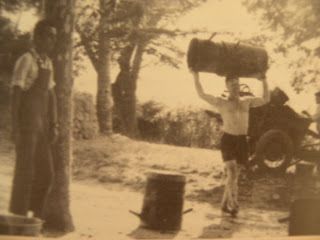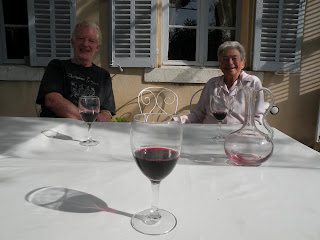As I mentioned in a previous blog, Lulu and Lucien were given Domaine Tempier as a wedding present when they were married in 1936. Along with the Domaine came some old pre-phylloxera bottles of wine.
Phylloxera was the great killer bug of French vines in the 1860s. It wiped out practically all of the vines in the whole country. The remedy, as it turned out, was to bring American vines over to
When Lucien tasted the old bottles from Domaine Tempier, he was stunned. Although the wine was quite old, it tasted wonderful, like nothing he had tasted before. So he started researching the history of Bandol wines and found that these old wines were made from the Mourvédre grape. Bandol wines were quite famous at one time and were exported all over
Lucien showing in that smile what is the essence of a good bottle of wine...
So in a tireless pursuit to resurrect Bandol wines, during the next several years he brought bottles of the old wines to the committee which decided what French wines should be put in the AOC. This stands for appellation d'origine contrôlée, which literally stands for ‘controlled designation of origin’. It is based on the concept of terroir, which is the idea that foods like wine and cheese develop a certain taste and character from where they are grown. There are many factors to terroir; the terrain, the soil, the plants that grow there, the very air itself. So for wine, when you have an AOC designation, you can only grow certain grapes that have been determined to grow the best in that particular terroir. In Burgandy, for example, the AOC law says you must grow Pinot Noir. In certain parts of
Lucien in his oufit as "Grand Cellerier of L'Ordre Illustre des Chevaliers de Meduse, 1992...
Here was the history of Bandol, right there in those old bottles of wine. The committee, which consisted of winemakers from all over
Lucien, Lulu and Louis (Lucien's twin), circa 1936...
When Lucien and Lulu inherited Domaine Tempier, the land they owned was mostly around the house, on flat land. Then in 1951, Lucien bought a terraced piece of land that the prior owner had planted with Mourvédre in 1941. So now he had some 10 year old Mourvédre vines to work with on a wonderful plot of land. In 1951, he bought the La Miguoa vineyard, with even more Mourvédre vines. In the ensuing years, he experimented constantly with different cuvees, some with more, some with less Mourvédre. Eventually he decided to make two cuvees, the regular and the Cuvee Speciale, which consisted of the Tourtine and Miguoa vineyards. It wasn't until the late 1960s that La Tourtine and La Miguoa were put in their separate cuvees.
Lucien (without shirt) working hard in the vineyards...
Lucien was originally from St. Etienne, an industrial city north of
Lucien and Lulu, circa 1936...
It is said that behind every winemaker is a winemaker's wife and the personality of the wine can reflect the character of the wife as much as the winemaker himself. This is certainly true with Domaine Tempier. Lulu Peyraud is energetic and earthy, but with a lot of finesse and a sparkle in her eye...just like their wine. She has been well known in wine circles in France since the 1950s and 1960s, when she gave parties that have since become legend. She even entertained the President of the Republic one time. She is known in the
Lulu with traditional cork fish paniers, circa 1968...
Lulu and Lucien have seven children, five daughters and two sons. Some of the daughters have worked at the Domaine from time to time, but the two sons have worked their almost their entire lives.
Lucien and Lulu with their first four children...from left, Francois, Jean-Marie, Fleurine and Marion, 1943...
Me, Lulu and Amy, October 2009...
Lulu and me enjoying a carafe of 2005 Miguoa, October 2009...
Marcel Pagnol himself couldn't have invented the two Peyraud brothers. Jean-Marie, as we have seen, has worked in the cellars most of his career. When Lucien was getting older and slowing down a bit, it was natural that this is where Jean-Marie would end up, the winemaker for Domaine Tempier. He alway enjoyed the job of creating this magnificent wine from the grapes his brother brought to him. His brother, Francois, on the other hand, tended more naturally to the outdoors, working with the vines and making sure the grapes that arrived for Jean-Marie were perfect and ready to be made into wine. Physically, this is a very demanding job and Francois has the muscles to prove it.
In America, it is usually the winemaker, the person actually making the wine, to get all the acolades. But in France, it is recognised that the person handling the vines in the field has just as important a job. Without Francois' great work with the vines, Jean Marie would never have the raw material to make such great wine.
Lunch in the vineyards, circa 1963. Jean-Marie is on the right...
The brothers Peyraud followed their father's winemaking techniques as much as possible. They added a few modern things, like stainless steel fermentation tanks, replacing the old wooden vats. But almost everything is done in the old way. They work the steep, terraced hillsides by hand. They don't use any chemical fertilizers or weed killers. Their is no irrigation. The only thing that waters the grapes is rain. They add no sulphur dioxide to the wine, as most wineries do. The absence of sulphur dioxide sometimes causes a tiny second fermentation in the bottle, which results in a slight "fiz", barely noticeable. I think this can be charming and it often reminded Annie of the 'country' wines she had in her youth.
Francois and Jean-Marie in a recent photo...
Francois making marc...
Jean-Marie, Lucien, Francois and Richard Olney tasting wine (date unknown)...
Jean-Marie and Lucien tasting...
And the wines just kept getting better and better. My personal experience is with wines made after the brothers took over (except for the amazing 1971 and the rosé from 1967) and I have never had a wine that was tired, never. I've drunk every vintage since 1980 and they have been consistently delicious. I recently had a magnum of 1982 Tourtine, 30 years old, and I could have waited another 10 years, it was that good.
Jean-Marie pouring a 40 year old bottle of rosé...
Jean-Marie and Francois had the perfect partnership and it went on for decades until their retirement in 2000. It was then that they hired Daniel Ravier as the winemaker, the first time since the 1930s that a person who is not a Peyraud was making the wine. But they found the right person, as Daniel understands what Domaine Tempier is all about and has continued to make the wine in essentially the same way. Jean-Marie and Francois continue as consultants. Last time we were there in May 2012, Jean-Marie and Francois had a tasting with Daniel and others at the Domaine to pick out what was to go into the Cuvée Classique 2010.
Daniel Ravier and Jean-Marie, May 2012...
So Domaine Tempier is in good hands and there is no reason not to believe that great wine will be made here for years and years to come. That is great news for someone like me, as otherwise I would be hording my ever dwindling supply of my favorite wine.
Jean-Marie and me in the Domaine Tempier vineyards, May 2012...












Hey, Craig, this is your cuz. Great article. I enjoyed the whole last 30 or 40 years with you and Annie and Amy and your friends in Marseille. Thank you for the whole story.
ReplyDeleteBrock